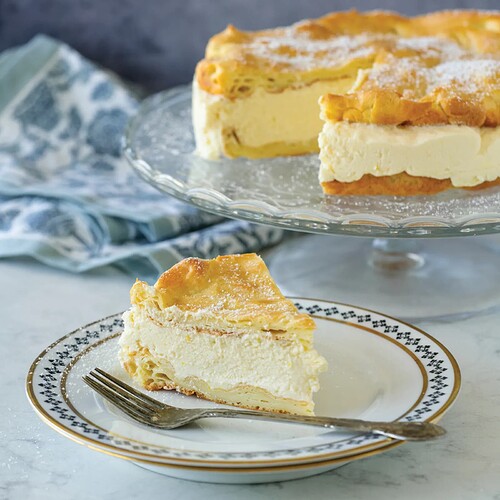Frosting:
2 cups whole milk
2 eggs
⅔ cup granulated sugar
¼ cup cornstarch
2 teaspoons pure vanilla extract
¼ teaspoon salt
2 tablespoons orange liqueur
Finely grated zest of 1 orange
¾ cup unsalted butter, at room temperature
Pâte à choux:
⅓ cup whole milk
⅓ cup water
6 Tbsp. unsalted butter
½ tsp. salt
¼ tsp. granulated sugar
¾ cup all-purpose flour
3 eggs
Sunflower or other neutral oil, for oiling the spatula
Confectioners’ sugar, for dusting
To make the frosting, in a medium saucepan, heat the milk to 180°F. While the milk is heating, in a medium-large bowl, whisk together the eggs, granulated sugar, cornstarch, vanilla, and salt until well blended. Carefully pour about half of the hot milk into the egg mixture while stirring constantly. Then slowly pour the egg mixture into the saucepan, stirring as you do, and cook over medium-low heat, stirring constantly with the whisk so the mixture doesn’t scorch on the bottom.
Heat the custard until it comes to a simmer and thickens, stirring constantly. It should have a pudding-like consistency and coat the back of a spoon . This should take about 5 minutes. Remove the custard from the heat and pour it into a heatproof container. Whisk in the orange liqueur and orange zest. Cover with a piece of plastic wrap, pressing it directly onto the surface to prevent a skin from forming. Set aside and let cool to room temperature.
Meanwhile, make the pâte à choux. Preheat the oven to 375°F. Cover the bottom and sides of two 8-inch springform pans with parchment paper.
In a medium, heavy saucepan, combine the milk, water, butter, salt, and granulated sugar and bring to a boil over medium-high heat. As soon as the mixture boils, add the flour and start stirring vigorously with a wooden spoon until a tight dough forms and pulls away from the sides of the pan, about 2 minutes. When you see a skin of dough forming on the bottom of the pan, remove the pan from the heat.
Let the dough cool for a few minutes, then add the eggs, one at a time, beating well after each addition with the wooden spoon until fully incorporated before adding the next egg. When all the eggs have been incorporated, you should have a glossy, thick, sticky batter.
Divide the batter evenly between the prepared springform pans, then spread the batter in each pan with an oiled rubber spatula. The surface doesn’t have to be too smooth. Transfer both pans to the oven and bake the pastry until golden, 25 to 35 minutes. Let cool completely in the pans on wire racks.
To finish the frosting, in a stand mixer fitted with the whisk attachment, whip the butter on medium-high speed until pale and fluffy, 3 to 4 minutes. Turn down the speed to low and start adding the cooled custard, 1 table-spoon at a time. Make sure each addition is fully incorporated with the butter before adding another spoonful. When all the custard has been incorporated, the frosting should be the consistency of whipped cream.
To assemble the cake, unclasp and lift off the sides from each springform pan . Then, using a wide spatula, carefully lift the layers from the pan bottoms . Reassemble one of the pans (make sure it is at room temperature), clasping the sides in place . Choose the flatter of the two layers and place it on the bottom of the reassembled pan . Top the layer with the frosting, smoothing it with a rubber spatula . Gently set the second layer on the frosting . Cover the pan with plastic wrap and refrigerate the cake until the frosting is firm and fully set, about 3 hours.
When ready to serve, unclasp and carefully lift off the pan sides. Using a long, wide metal spatula, carefully lift the cake from the pan bottom and transfer it to a serving platter. Dust the cake with confectioners’ sugar and slice it into serving pieces.
